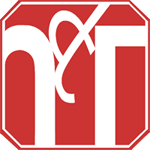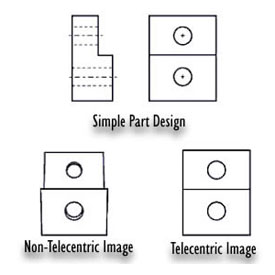 |
|
|
|
|
Objective Lenses The optics are the heart of any comparator. When you think about it, the lenses in a comparator are really gages. Why? Because it is the image they form that is measured, not the part itself. And to make sure the image is accurate, optical quality (in design and manufacture) is critical. You will find several different types of optics offered on optical comparators. Regardless of the type, however, the optics must be free of distortion (magnification change across the image), produce a flat field (image over the entire screen is in sharp focus), and have excellent resolution (sharpness of the image). Let us take a look at each type and discuss the relative merits of each. The least expensive systems often employ simple optics. In this case, a projection lens magnifies the object and the image is directed to the screen by one or two mirrors. If one mirror is used, the image is inverted (upside down) and reversed (left to right). With two mirrors, the image is correct top to bottom, but still reversed. This second system is often referred to as corrected optics.
In a simple lens system, changing magnification involves removing a lens from the front of the machine and replacing it with another. Some systems make this more convenient by providing a multiple lens slide or turret. In most cases, however, working clearance (the space between the part undergoing inspection and the optics) decreases as the magnification is increased. For three dimensional parts, this means that inspection at higher magnifications (50x - 100x) is generally limited to flat parts, prismatic parts with little thickness, or turned parts of small diameter. J&L METROLOGY’s Focus is a unique corrected optics system, since it has a constant working distance and an internal lens turret. Relay Lens and Fully Corrected Optics Relay lens systems use additional optics to form an intermediate image (usually at 1x magnification) which is in turn magnified by the projection lens. The final image is fully corrected, or in other words, erect and unreversed.
Another important benefit afforded by fully corrected optics is a constant working clearance, regardless of magnification. There is no limitation on part size or thickness due to the magnification selected. Due to the extra optics in relay lens systems, the magnification lenses are usually arranged in an internal turret, often motorized for convenience. The closer an object is to you, the larger it appears. This is one of the fundamental principles of optics. The same is true for any optical system, whether your eye, a camera, or an optical comparator. But this can cause an error when measuring a three dimensional part, or if the image is simply a little bit out of focus. Why? Because adjusting the focus on a non-telecentric, simple optics system changes the distance between the part and the optics, and that changes the magnification. The effect is not that large (typically several thousandths of an inch measured at the part), but in today’s world of ever shrinking tolerances, you need to be as precise as you can. Telecentric relay lens optics were developed by J&L METROLOGY and Eastman Kodak in 1945 to alleviate this problem. Here is a good example that shows the difference between non-telecentric and telecentric optics: A simple part, with a step and two through holes machined into it, will appear "in perspective" to a non-telecentric system, as shown below (the effect is exaggerated for clarity). The machined step on the top (which is farther away from the optics) looks smaller. A telecentric system will create an image free from this effect, with no measurable difference in magnification.
All J&L METROLOGY optical comparators feature true telecentric optical systems. Some manufacturers claim "telecentric illumination" but you owe it to yourself to verify the benefits of such a system. Only an optical system designed from the start as telecentric delivers the advantages stated above.
|
© 2011 J&L Metrology, Inc. – Springfield, VT USA. All Rights Reserved
Web Site Designed by William Mahony Designs



